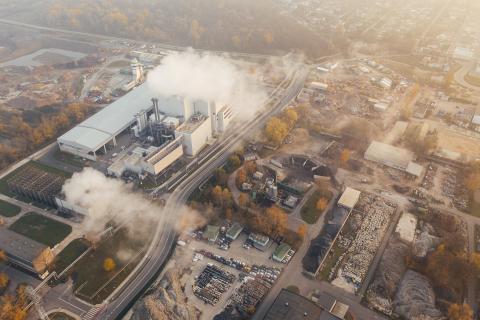2024 was the first year to exceed 1.5 °C above pre-industrial levels
The year 2024 was the warmest year on record globally and the first calendar year in which the global average temperature exceeded its pre-industrial level by 1.5 °C, the Copernicus Climate Change Service has confirmed.

Ernesto - 1,5 (EN)
Ernesto Rodríguez Camino
Senior State Meteorologist and president of Spanish Meteorological Association
First of all we should mention that the reports and press releases produced by the Copernicus Climate Change Service (C3S) are highly respected and influential reports, to the point that the United Nations Secretary General, António Guterres, regularly quotes them in his speeches on climate.
This press release summarizes the main climate features of the year 2024, with perhaps the most relevant finding being that it was the warmest year globally since records began and the first calendar year in which the average temperature was 1.5 °C above the pre-industrial level. The fact that in the Paris Agreement the signatory parties committed themselves textually to “pursue efforts to limit the temperature increase to 1.5°C above pre-industrial levels, recognizing that this would significantly reduce the risks and impacts of climate change” means that this limit that we have just exceeded in 2024 has the great symbolic value that what is being done to limit the greenhouse gas emissions causing this progressive temperature increase is clearly insufficient.
In any case, 2024 has been very warm, both in terms of air and sea surface temperature, plus the additional contribution of the positive El Niño phase to the underlying warming trend caused by the continued increase in greenhouse gas emissions. The 1.5 °C or 2 °C limits set in the Paris Agreement on climate change do not refer to a single specific year, as has happened in 2024, but to the average over a certain number of years that filters out annual oscillations due to phenomena such as El Niño. What is really important is to prevent that figure from becoming a new long-term norm. In addition, this report notes the increase in the frequency and intensity of extreme weather events around the world-from severe storms and floods to heat waves, droughts and wildfires-as related to the context of climate change. In fact, the individualized study of extreme weather and climate events through attribution studies has made it possible to quantitatively estimate the increasing role of climate change in the occurrence of these phenomena.
Cabré - 1,5
Anna Cabré
Climate physicist, oceanographer and research consultant at the University of Pennsylvania
We have been seeing news of this kind for several months now: that 2024 will be/has been the warmest year so far. The fact that the 1.5 °C limit has been reached for the first time gives the situation even more urgency. This underlines the need to invest more in adaptation and, above all, not to lose sight of the 1.5 °C target and use it as a motivation to move more decisively towards solutions, before the extremes become too dangerous or we reach the points of no return.
Víctor Resco - 1,5 ºC EN
Víctor Resco de Dios
Lecturer of Forestry Engineering and Global Change, University of Lleida
In Spain we have the impression that this year has not been particularly hot because the summer was milder than in the two previous years. However, globally we have reached a new record of 1.5 ºC [increase]. Climate provides the basis on which every society is built: urban planning, industry, tourism, agriculture and forests, to give a few examples, depend on the climate in each area. Climate change therefore affects all these sectors. Until now we have considered the safe level of warming, the one that does not critically affect society, to be 2°C, a figure that is getting closer and closer.
As CO2 concentrations in the atmosphere continue to rise, warming will continue to progress and the 2°C threshold will be exceeded in a few decades. Adaptation to climate change is therefore becoming increasingly urgent and important. Climate change does not create mega-fires and catastrophic floods on its own, but it does increase the intensity with which flames burn and storms rage. We must therefore implement now the strategies that we know work to protect us from these extreme events. Last year's floods or the fires of 2022 are just a trailer for the future that awaits us. We must start laying the groundwork to adapt our cities, industries, tourism, agriculture and forests to the new climate. It is up to us to lessen the most dire consequences of this new world.
Doblas - 1,5 (EN)
Francisco J. Doblas-Reyes
ICREA Professor, Director of the Earth Sciences Department at the Barcelona Supercomputing Center
The quality of the report is excellent, as in previous years. C3S - the Copernicus Climate Change Service - has become a reference in monitoring the state of the global climate. Its relevance to European interests is immense. It is de facto the authority at the scientific level, and hopefully also at the policy level, on the extent of anthropogenic climate change, to which natural climate variability is superimposed.
The report confirms what has been announced for some months: that 2024 was the warmest year on record and that for the first time the threshold of a global warming level of 1.5°C (relative to the period 1850-1900) has been exceeded on an annual average. This fact, which was already predicted earlier this year in the annual reports of the BSC and the World Meteorological Organization, puts the global climate system on a trajectory where the probability of exceeding the first threshold of the Paris Agreement, which is for long-term global warming of 1.5°C, is increasingly high. It is to be expected that the rate of warming will not continue at the same rate in the coming years. The new set of decadal predictions that will be available in February will inform us about the likelihood of this occurring.
While the report places much emphasis on the warming in the global oceans, which is in part a continuation of the extraordinary levels reached in 2023, the warming over much of the continents is very striking. Given the interest in what is happening, the scientific community is working to identify the physical reasons, beyond the increased concentration of greenhouse gases, that have produced two years in a row of such high temperatures.
The rate at which global temperatures will continue to rise is not yet known. For this we need the new decadal predictions and a detailed analysis of the factors (anthropogenic, volcanic, biogenic and mineral aerosol changes, ocean heat content, natural variability in the ocean, etc.), which are behind what has happened in 2023 and 2024. The BSC is working with C3S and other international institutions in both directions.
Otto _ 1,5 (EN)
Friederike Otto
Senior Lecturer at the Centre for Environmental Policy, Imperial College London
This record needs to be a reality check. The climate is heating to levels we’ve spent years trying to avoid because countries are still burning huge amounts of oil, gas and coal.
A year of extreme weather showed just how dangerous life is at 1.5°C. The Valencia floods, US hurricanes, Philippines typhoons and Amazon drought are just four disasters last year that were worsened by climate change. There are many, many more.
The world doesn’t need to come up with a magical solution to stop things from getting worse in 2025. We know exactly what we need to do to transition away from fossil fuels, halt deforestation and make societies more resilient to the changes in the climate we see in so clearly in this report.
Rogelj - 1,5 (EN)
Joeri Rogelj
Director of Research at the Grantham Institute – Climate Change and Environment, Imperial College London
A single year with temperatures 1.5°C above preindustrial levels does not mean we’ve reached 1.5°C of global warming. However, it does mean we’re getting dangerously close.
The Paris Agreement sets limits to global warming not out of convenience but out of the necessity to limit harm to and suffering of people. Even if we surpass 1.5°C in the long term, these reasons don't change.
Every fraction of a degree—whether 1.4, 1.5, or 1.6°C—brings more harm to people and ecosystems, underscoring the continued need for ambitious emissions cuts.
While the hottest year on record is alarming, the case for action makes more sense than ever: the cost of solar and wind energy is falling rapidly and is now cheaper than fossil fuels in many countries. Governments can build healthy economies with stronger, more decisive action to accelerate the transition to clean energy.
Ceppi - 1,5 (EN)
Paulo Ceppi
Senior Lecturer in Climate Science at the Department of Physics, Imperial College London
It's unlikely 2025 will be as hot as 2024, but people shouldn’t think that’s climate change hitting pause or plateauing.
There are ups and downs in global temperatures due to natural processes, like El Niño, and a small dip doesn’t change the clear upward trajectory we’re on.
The recent heat was exacerbated by a decrease in the amount of cloud and sea ice, causing Earth to absorb more sunlight. This confirms climate model predictions of melting sea ice and shrinking cloud cover as the world warms.
Countries have the power to bring global warming to a halt by reducing greenhouse gas emissions to net zero. This must happen as quickly as possible to give us some hope of preventing further global climate change catastrophes.



